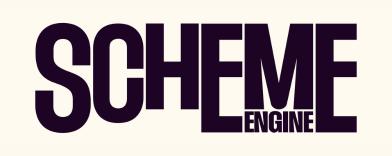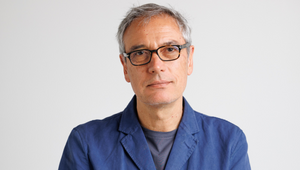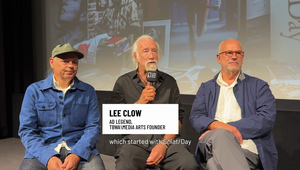
Your Shot: A Kenyan Coffee Adventure for MTN

Creativity is all about risks, taking a leap into the unknown. And for co-directors Daniel Levi and Oliver Hermanus, their recent project for African telecoms giant MTN with agency Metropolitan certainly required a lot of bravery and trust. They headed to Kenya with their production company Goodcop and Kenyan company Ginger Ink to create a loose, street cast documentary-style ad. Despite thorough pre-production there were still plenty of unknown factors, including the cast and safety as the shoot took place shortly after the Westgate Mall attack in Nairobi. LBB’s Addison Capper caught up with Daniel Levi to find out how trust and authenticity turned the project into a rewarding adventure.
LBB> What was the initial brief like from the agency? What appealed to you about it?
DL> The agency brief was to show the coffee trade as an example of how MTN helps facilitate Pan-African business on so many levels. A few concepts were discussed. One idea was the POV of a coffee bean. Another was a more graphic approach using animated illustrations and live action mixed.
Pete Khoury and George Low from Metropolitan are smart, free-thinking creative directors who understand the value of trust in the film making process, from conception to production. They were very open to seeing different treatments and when I proposed a documentary approach and a trip to East Africa they got excited. The footage from our trip would be intercut with a candid conversation between two men to explain the process without ‘explaining’ it. They went for it.
What appealed to me, ultimately, was the potential to find the humanity in the coffee trade and to capture something about the unique beauty of Africa.
LBB> What was the pre-production and research process like for the film?
DL> We shot the coffee shop scene in Cape Town. Goodcop, my South African production company, produced everything locally – they are another forward-thinking group of people with a very creative, independent approach to production, which is important to me. The pre-production in Cape Town involved fairly normal stuff - location scouting, casting, wardrobe. The rest of the pre-production was less conventional. We remotely scouted Uganda, Tanzania and Kenya via local production companies over there.
In spite of the recent attack at the Westgate Mall, we decided to base the production out of Nairobi because Kenya, we felt, had the most visually interesting coffee fields, processing facilities and warehouses. The key to the research and pre-production for Kenya was to get a feel of who the people involved in the coffee trade were – from an agriculture level to the actual business of it. And we wanted to find farms and processing facilities that we liked. We had a Kenyan scout who extensively photographed people, places and landscapes. We narrowed down a plan of travel in and out of Nairobi based on the images we liked and the practicalities of travelling and shooting in the time we had. Once we had a rough plan we went over and spent four days shooting with a tiny crew, including my DOP Jamie Ramsay and right hand man and co-director Oliver Hermanus, both South African. We used our instincts, eyes and experience to guide us. The agency and client were very trusting about the whole process, especially given we were going in without specific cast and exact locations locked down. We all acknowledged the client's bravery in this and, ultimately, we were happy when they recognised how it paid off.
LBB> The film's look is quite dark - why did you choose to use that kind of aesthetic to portray the ad's message?
DL> The dark part of the film is really the coffee shop. The reason was that we wanted to use natural light and wanted it to feel dim and intimate. We chose a coffee shop that naturally had this kind of atmosphere – most of the coffee shops we saw were too bright and sterile. The choice in lighting was a decision based mainly on achieving a warm, personal mood.
LBB> And how did you keep that aesthetic and message consistent throughout?
DL> The aesthetic was determined mainly by the use of natural light. Instead of forcing a slick beauty on to scenes by using artificial or added light, we chose rather to use our eyes to find the best angle for the available light with an aim toward finding a natural beauty. Most of the days in Kenya were overcast, which gave us a softer look. In post production we worked on a grade that reflected what we really saw – the natural exposure of things – rather than impose too much of a look or brighten things up too much.
LBB> Whose voice is used for the voiceover? His performance is great - how did you coax it out of him?
DL> Fana Mokoena is the main voice. Casting him was key. He is a wonderful actor and needed little coaxing. You may remember him from World War Z? We gave him a solid character brief and explained the context and relationship to the younger man he's talking to. We also told him that this is a natural, character driven piece – a conversation – not a voice-over. He took over from there. Of course it was also George Low's great script that was at the core of this.
LBB> Who are the people that feature in the film? Are they actors or street cast people?
DL> Everyone in the Kenyan part of the film are people we found along our journey. They are all people who work in the coffee trade – berry pickers, sifters, farmers, admin etc. In the film, they are simply doing what they do for a living without too much direction. I didn't want to force people to do anything unnatural.
We had a great local 1st AD who helped enormously to gain people's trust and negotiate fairly with people – it was important to us that no one was exploited in any way. With our crew being small we tried to be as unimposing as we could with the hope that this would show in the candid feel of the spot.
LBB> What was the shoot like as a whole? What were the biggest challenges during production and how did you overcome them?
DL> It was rewarding. Travelling through Kenya was inspiring and as a whole I look back on the experience with really positive memories. I was lucky – I had great support from Goodcop and Metropolitan. They trusted me and gave me the space to do my job. Oliver Hermanus was an invaluable asset and the crew from Ginger Ink in Kenya were very supportive and friendly. As far as challenges go, the biggest issue we had was dealing with the apprehension around the Westgate Mall attack in Nairobi that had happened a few weeks before we got there. Our fears were allayed by our Kenyan team and from there the biggest challenge was the daily 4am call time!
Credits
Director: Daniel Levi
Co-director: Oliver Hermanus
Production Company in SA: Goodcop
Produced by: Tess Van Zyl
DOP: Jamie Ramsay
Production Company in Kenya: Ginger Ink
Producer in Kenya: Guy Wilson
Agency: Metropolitan, Johannesburg.
Creative Directors: Pete Khoury & George Low
Agency producer: Nicola Martin.















